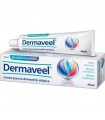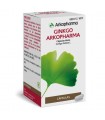Omeprazol Healthkern contains omeprazole as the active substance. It belongs to a group of medicines called proton pump inhibitors. These medicines work by reducing the amount of acid produced by the stomach.
Omeprazol Healthkern is indicated in adults for the short-term treatment of reflux symptoms (e.g. burning, acid regurgitation).
Reflux is the rise of acid from the stomach to the esophagus, which can become inflamed and hurt. This can cause symptoms such as a painful burning sensation in your chest that goes up to your throat (burning) and a sour taste in your mouth (acid regurgitation).
You may need to take the capsules for 2-3 consecutive days to achieve an improvement in symptoms. You should see a doctor if it gets worse or if it doesn't improve after 14 days
ACTION AND MECHANISM
- Peptic antiulcera, H+/K+ pump inhibitor. Omeprazole is a benzimidazole that acts as a specific, non-competitive and irreversible inhibitor of the proton pump (PPI) or ATPasa H+/K+, located on the surface of the gastric parietal cell. Blocking the proton pump prevents the production of gastric acid, both basal and before a stimulus, regardless of whether it is (acetylcholine, gastrin or histamine).
Omeprazole is a racemic mixture of two stereoisomers, S-omeprazole (esomeprazole, pharmacologically active) and R-omeprazole (no activity on acid production).
Omeprazole is a prodrug with a weak-based nature, which after absorption is distributed by the body, and especially in the light of the secretor canals of the parietal cell. Here, and in the presence of acidic medium, it undergoes a non-enzymatic chemical reaction resulting in the active form, a fully hydrophilic sulfonamide derivative, which tends to accumulate in the canals and bind to the proton pump by disulfide bridges with cysteine residues from the alpha-luminal chain.
Due to the formation of covalent bonds, the only way for the parietal cell to recover its secreting activity is the synthesis of new pumps, which is a great period of time and explains the long duration of the effects of PPIs, which can last up to 4 days after administration of a single dose, and despite their low t1/2.
Administration of a dose of omeprazole of 20 mg resulted in a reduction in pentagastrin-induced acid secretion of 70% at 24 hours of administration.
Effects on acid production begin to appear after 2 hours, although it may take up to 5 days for maximum antiulcer activity to be achieved. Its effects may be prolonged, and in some studies acid secretion inhibition of 26% (20 mg) and 48% (mg) has been observed at 24 h of administration.
SPECIAL WARNINGS
- It is recommended to confirm the healing of ulcerations by endoscopy before stopping treatment.
- PPIs may mask symptoms of esophageal or stomach digestive tumors. It is recommended to closely monitor patients treated with PPIs for extended periods of more than 1 year. If the patient experiences symptoms such as significant and unwarranted weight loss, frequent vomiting, dysphagia, hematemesis or mane, a differential diagnosis is recommended.
- In case of severe and prolonged diarrhoea, possible Clostridium difficile infection will be investigated.
- Treatment with PPIs for an extended period of time has rarely resulted in severe tables of hypomagnesaemia, which could be associated with hypocalcaemia. If the patient experiences symptoms such as asthenia, dizziness, tetany, seizures or cardiac arrhythmia magnesium levels will be determined, and in case of hypomagnesemia treatment will be discontinued and a magnesium supplement will be administered.
- Antiulcers may interfere with the diagnosis of neuroendocrine tumors by increasing levels of the specific marker chromogranin A (CgA), resulting in false negatives. Stop the antiulcer at least 5 days before the test, and if your levels had not been normalized, repeat the test within 14 days of suspension.
- Monitoring:
* Magnesium levels at baseline and periodically in patients treated for long periods with omeprazole, treated with digoxin or drugs that could lead to hypomagnesaemia, such as diuretics.
Elderly
No specific problems have been reported in elderly people forcing a dosing readjustment.
PATIENT ADVICE
- Do not stop treatment until directed to do so by your doctor, even if the symptoms have disappeared. A premature suspension could cause symptoms to recur.
- Tell your doctor about the medicines you are taking.
- Tell your doctor and/or pharmacist if you have any of these symptoms:
* Intense and/or persistent diarrhea.
* Significant and unwarranted weight loss, frequent vomiting, difficulty swallowing or presence of blood in vomiting or faeces.
* Unwarranted tiredness, dizziness, muscle stiffness, seizures or cardiac arrhythmias.
* Appearance of skin lesions, especially in areas exposed to the sun, accompanied by joint pain.
Contraindications
- Hypersensitivity to omeprazole, any other PPIs, or any other component of the medicinal product.
- Joint treatment with nelfinavir (see Interactions – Protease Inhibitors).
DRIVING EFFECTS
It does not appear to have significant effects. Dizziness, and rarely blurred vision and vertigo, are rarely reported.
Pregnancy
Animal safety: omeprazole did not result in teratogenicity when administered in rat or pregnant coneja at doses 345 and DMRH 172, although there was an increase in fetal mortality.
Safety in humans:the gestational safety of PPIs (including lansoprazole, omeprazole and pantoprazole) has been evaluated in several clinical trials and meta-analysis, and no teratogenic effects or embryotoxicity have been found, although they cannot be completely ruled out, especially in the case of rare foetal adverse reactions or delayed onset. However, depending on the information obtained in animal studies, the risk would not be very high.
Omeprazole crosses the placenta. It is recommended to use it with caution, restricting its use to situations where there are no safer therapeutic alternatives, and the benefits outweigh the potential risks.
Effects on fertility: no specific studies have been conducted on its effects on fertility.
Pharmacokinetics
Oral, parenteral route:
Omeprazole is a prodrug, and after absorption and distribution to the parietal cell, it is transformed by a chemical reaction catalyzed into acidic medium in the active sulfonamite derivative.
Indications
- Short-term treatment of symptoms of [GASTROESOFAGICAL REFLUJO], such as [GASTRIC HYPERACIDEZ] or acid regurgitation in adults.
Interactions
- Oral anticoagulants. Cases of increases in INR have been reported in patients treated with an anticoagulant and PPI. It is recommended to use with caution, monitoring the INR.
- Clopidogrel. Omeprazole at high doses could decrease the effect of clopidogrel by inhibiting transformation to its active metabolite, mediated by CYP2C19 (although there may be some other mechanism since clopidogrel has several metabolic pathways). It is recommended to avoid association between omeprazole and clopidogrel. Pantoprazole, and to a lesser extent lansoprazole and rabeprazole, could be safer alternatives.
- Disulfiram. A case of catatonic reaction when combining with omeprazole has been reported.
- Drugs with pH-dependent absorption. The increase in pH produced by antiulcers may modify the absorption of certain medicinal products by favoring or reducing their dissolution in the aqueous environment of the gastric content. Thus an increase in the absorption of digoxin has been observed, as well as a reduction in that of azlic antifungals (itraconazole, ketoconazole, posaconazole), mycophenolate mofetil, rilpivirine, vitamin B12 and tyrosine-kinase inhibitors (dasatinib, erlotinib, gefitinib, lapatinib, nilotinib, pazopanib).
Digoxin toxicity is rare, but caution is advised for serious effects in elderly patients treated with high doses. It is recommended to monitor plasma levels of digoxin.
- Enzyme inducers/inhibitors. Omeprazole is metabolised by CYP2C19 and to a lesser extent CYP3A4, so its plasma levels could be modified by potent inhibitors (fluconazole, fluvoxamine, ticlopidine) or inducers (rifampicin) of both isoenzymes. There are also certain risks with drugs affecting a single isoenzyme, especially CYP2C19, which is the majority. A dosological readjustment is not considered necessary, as the effect would be like that observed in slow metabolisers, but could be more important in case of severe hepatic impairment and long-term treatment.
- Protease (IP) inhibitors. PPIs could alter the plasma levels of certain IPs, either by increasing pH or by inhibiting CYP2C19.
Significant reductions in plasma levels of nelfinavir and atazanavir have been reported. Joint administration with nelfinavir is contraindicated, and it is not recommended to combine with atazanavir. If it is not possible to avoid this association, it is recommended to increase the dose of atazanavir from 300 to 400 mg, although this dose increase did not fully counteract the effect on the plasma levels of atazanavir, so the response should be evaluated in the patient.
An increase in saquinavir levels has been reported up to double.
Finally, no major pharmacokinetic alterations have been observed when combining with amprenavir, darunavir, fosamprenavir, lopinavir or tipranavir.
- Methotrexate. PPIs may increase serum levels of methotrexate.
- CYP2C19 substrates. Omeprazole is a moderate CYP2C19 inhibitor, so it could increase plasma levels of drugs that are metabolised by this system, such as certain tricyclic antidepressants (clomipramine, imipramine), cilostazole, citalopram, diazepam, phenytoin, voriconazole or warfarin. Doses of these drugs may need to be reduced, especially in case of on-demand treatments with PPIs.
In the case of phenytoin and warfarin it would also be advisable to monitor your plasma levels at the start and end of treatment with omeprazole.
- Tacrolimus. Increased serum levels of tacrolimus have been reported when administered with omeprazole.
No pharmacological interactions have been found when associating with antacids, beta-blockers (metoprolol, propranolol) domperidone, fluoroquinolones or theophiline.
Breast feeding
Animal safety: administration to lactating rats (35-345 MDRH) was associated with a reduction in the weight gain of the young.
Human safety:omeprazole is excreted in human milk, reaching levels of 7% of breast cp. The consequences that it could have for the infant are unknown, although it should be noted that PPIs are labile drugs at acid pH, which is why they are administered orally as gastro-resistant forms. It is recommended to stop breastfeeding or avoid administration.
RULES FOR PROPER ADMINISTRATION
- Gastro-resistant capsules: ingest whole with the help of half a glass of liquid. They should not be chewed, crushed or split.
If the patient experiences difficulty swallowing the capsules, they may open and suck or suspend their contents in half a glass of unspoyted water, fruit juice or soft foods such as applesauce. Suspension with granules should be drunk immediately or within 30 minutes. Then fill the glass halfway with water and hurry the contents. Granules should not be chewed or crushed.
Suspension of granules in milk or gas water is not recommended.
Administration with food: preferably administer fasting, first thing in the morning.
Dosage
"Oral administration"
- Adults:
POSOLOGY IN HEPATIC IMPAIRMENT
Normally a dose of 10-20 mg/24 h is sufficient.
POSOLOGY IN RENAL INSUFFICIENCY
No dosing adjustment required.
Precautions
- [HEPATIC INSUFFICIENCY]. Liver failure could increase exposure by reducing the first-step liver effect, and decrease elimination by reducing metabolism. However, omeprazole has been shown not to tend to accumulate in these patients when administered once daily. It is advised to use with caution. Patients with hepatic impairment may require a lower maintenance dose.
- [DIGESTIVE INFECTIONS]. Increased gastric pH produced by antiulcers could promote colonization of the digestive system by certain pathogenic microorganisms, such as Salmonella, Campylobacter and even Clostridium difficile in hospitalized patients. A differential diagnosis of [COLITIS PSEUDOMEMBRANOSA] is recommended in patients treated with an antiulcer in which severe diarrhoea occurs.
- [CIANOCOBALAMIN DEFICIT]. Increased pH produced by antiulcer drugs could decrease the absorption of cyanocobalamin, so it is recommended to take this into account in people with low deposits of this vitamin, such as in patients with [DESNUTRIATION] or strict vegetarian diets without supplementation is this vitamin, or situations in which its absorption could be reduced, such as in [CRONICO ALCOHOLISM], [MALABSORCION INTESTINAL] or situations that could lead to malabsorption , such as [INTESTINAL INFLAMMATORY DISEASE] or major surgical processes of the digestive system.
- [HYPOMAGNESEMIA]. Treatment with PPIs has been linked to severe cases of hypomagnesaemia, which could be associated with [HIPOCALCEMIA]. Its frequency has not been estimated, but it is considered rare. However, the high use of these drugs should be taken into account, so their clinical impact could be significant. Most patients with hypomagnesaemia were undergoing long-term treatment (at least 3 months and mainly 1 year).
It is recommended to monitor magnesium levels at the start of treatment and periodically throughout treatment in patients receiving long-term PPIs, digoxin treatment or drugs that could lead to hypomagnesaemia, such as diuretics.
Magnesium levels will be determined if symptoms of hypomagnesaemia occur, such as tiredness, dizziness, tetany, delirium, seizures or cardiac arrhythmia. Hypomagnesemia responds to the elimination of PPIs and magnesium supplementation.
- [OSTEOPOROSIS]. Administration of PPIs at high doses and for extended periods of time (> 1 year) has been linked to an increased risk of hip, wrist and vertebral fracture, especially in the elderly and with risk factors. It is therefore advised that women with osteoporosis receive adequate treatment and intake of calcium and vitamin D.
- [NEUMONIA]. PPI treatment has been linked to cases of pneumonia, including community-acquired pneumonia (CAP), interstitial pneumonia, or nosocomial pneumonia. The risk appears to be higher in patients who have just started treatment (especially < 2 days), without longer-term treatments.
- [SUBACUTE CUTANEOUS ERYTHEMATOUS LUPUS] (LECS). PPIs have been linked to very rare cases of subacute skin lupus erythematosus. In case of skin lesions, especially in areas exposed to the sun, accompanied by arthralgia, consider discontinuation of treatment. Patients with LECS by PPI may re-experience this picture if they receive a different PPI.
- Analytical interference. Increased gastric pH induced by antiulcers may increase plasma levels of gastrin (which usually return to baseline at 4 weeks of discontinuation of treatment) and chromogranin A (CgA).
CgA is a specific marker of neuroendocrine tumors, so antiulcers could result in false positives when this marker is used in diagnostic tests. Therefore, any antiulcers should be discontinued at least 5 days prior to the determination of CgA. If CgA levels have not been normalized in this period, the test should be repeated 14 days after the antiulcer suspension.
- Long-term treatment. Antiulcers eliminate symptoms related to acid diseases, which are common to those of malignant processes such as [CANCER OF STOMAGO] or [CANCER OF ESOFAGO]. Therefore, there is a risk of delaying the diagnosis of these processes.
It is recommended that patients receiving prolonged treatment, longer than one year, be monitored regularly and be advised to report other symptoms associated with these neoplasms, such as significant and unwarranted weight loss, recurrent vomiting, dysphagia or vomiting in blood or faeces. In case of suspected serious digestive process it is recommended to make a differential diagnosis.
EXCIPIENT PRECAUTIONS
- This medicine contains sucrose. Patients with hereditary [FRUCTOSA INTOLERANCE], glucose or galctose malaabsorption, or sucrose-isomaltase insufficiency should not take this medicine.
ADVERSE REACTIONS
Adverse reactions of omeprazole appear to be dose-independent. The most common are digestive in nature, as well as headache.
In studies, the safety profile in children was similar to that recorded in adult patients. There are no long-term safety data in children, nor on the effects on growth.
Adverse reactions are described according to each frequency interval, considered very common (>10%), common (1-10%), uncommon (0.1-1%), rare (0.01-0.1%), very rare (<0.01%) or of unknown frequency (cannot be estimated from the available data).
- Digestives: frequent [NAUSEAS] and [VOMITOS], [ABDOMINAL PAIN], [STRESS], [DIARREA], [FLATULENCE]; [MOUTH DRYNESS], [STOMATITIS], [CANDIDIASIS]; unknown frequency [PANCREATITIS].
- Liver: uncommon [INCREASE OF TRANSAMINASAS]; [HEPATITIS] with or without [ICTERICIA]; [HEPATICA INSUFFICIENCY], [ENCEFALOPATIA HEPATICA] in patients with previous liver disease; unknown frequency [COLESTASIS].
- Cardiovascular: unknown frequency [ARTERIAL HYPERTENSION], [PALPITATIONS], [ANGINA DE PECHO], [RAYNAUD'S SYNDROME].
- Neurological/psychological: common [CEFALEA]; [DIZZINESS], [PARESTESIA], [SOMNOLENCIA], [INSOMNIA]; [NERVIOSISMO], [CONFUSION], [DEPRESION], [DISGEUSIA]; very rare [ALUCINATIONS], [AGRESIVITY]; unknown frequency [ATAXIA].
- Respiratory: frequent [TOS], [RESPIRATORY INFECTION]; [BRONQUIAL SPASM]; unknown frequency [NEUMONIA].
- Genitourinarias: rare [INTERSTITIAL NEPHRITIS]; very rare [GINECOMASTIA]; unknown frequency [GALACTORREA], [SERICA CREATININE INCREASE].
- Dermatological: uncommon [DERMATITIS], [PRURITO], [EXANTEMATIC ERUPTIONS], [URTICARIA]; [ALOPECIA], [PHOTOSENSITIVITY REACTIONS]; very rare [ERYTHEMA MULTIFORME], [TOXIC EPIDERMIC NECROLYSIS], [STEVENS-JOHNSON SYNDROME]; unknown frequency [ANGIOEDEMA]; unknown frequency [SUBACUTE CUTANEOUS ERYTHEMATOUS LUPUS].
- Allergic: rare [HYPERSENSITIVITY REACTIONS], with [FIEBRE], [ANGIOEDEMA] or [ANAFILAXIA], and [LUPUS ERYTHEMATOSUS].
- Osteomusculars: frequent [BACK PAIN]; uncommon [HIP FRACTURE], [VERTEBRAL FRACTURE] or wrist fracture; [OSTEOMUSCULAR PAIN], [MIALGIA]; very rare [MIASTENIA]; unknown frequency [RHABDOMYOLISIS].
- Ophthalmological: rare [VISION BORROSA]; [NEURITIS OPTICA], [NEUROPATIA OPTICA].
- Erotics: uncommon [VERTIGO].
- Haematological: rare [LEUCOPENIA], [TROMBOCITOPENIA]; [AGRANULOCITOSIS], [PANCITOPENIA]; [NEUTROPENIA], [HEMOLITIC ANAEMIA] or [ANAEMIA MEGALOBLASTICA].
- Metabolic: rare [HIPONATREMIA]; unknown frequency [HYPOMAGNESEMIA], [HYPERCALCEMIA], [HYPOGLYCEMIA], [HIPOPOTASEMIA], [CIANOCOBALAMIN DEFICIT], [WEIGHT GAIN].
Hypomagnesaemia may occur with [ASTENIA], [MAREO], [TETANIA], [DELIRIO], [CONVULSIONES] or [CARDIAC ARRHYTHMIA] among others. Magnesium levels will be determined in case of symptoms. Hypomagnesemia responds to the elimination of PPIs and magnesium supplementation.
- General: frequent [ASTENIA], [FIEBRE]; [GENERAL MALAISE], [MALEOLAR OEDEMA]; [HIPERHIDROSIS].
Overdose
Symptoms: single doses of up to 2,400 mg, equivalent to DMRH 120, have been administered. No serious or irreversible adverse reactions have been reported, and in most cases patients had symptoms such as nausea and vomiting, abdominal pain, diarrhea, dizziness, headache, depression, apathy or confusion.
Measures to be taken:
- Antidote: there is no specific antidote.
- General disposal measures: administer active charcoal in case of very serious poisoning, although it is not usually necessary. It is not expected to be easily dialysable due to its high plasma protein binding.
- Monitoring: clinical condition of the patient.
- Treatment: symptomatic.



































